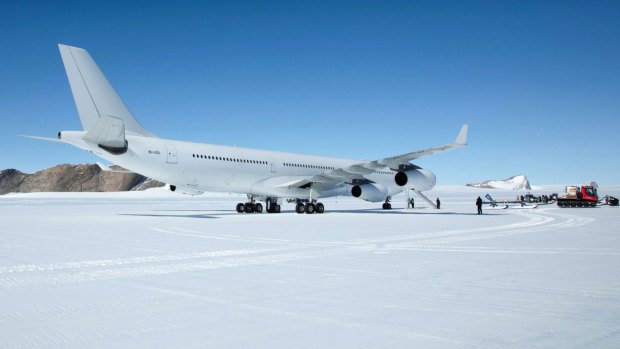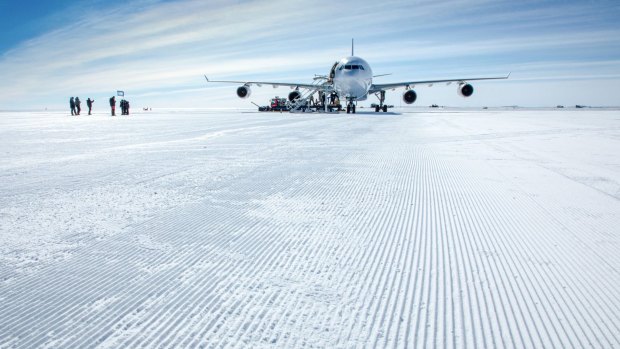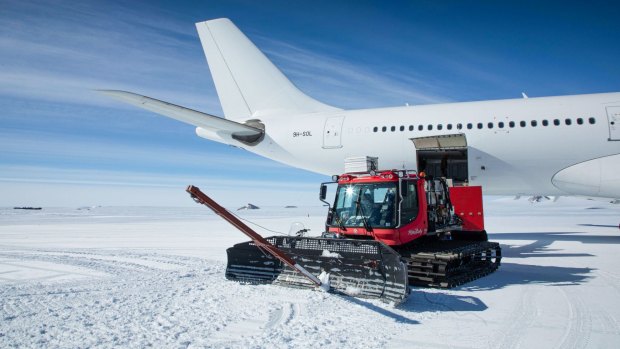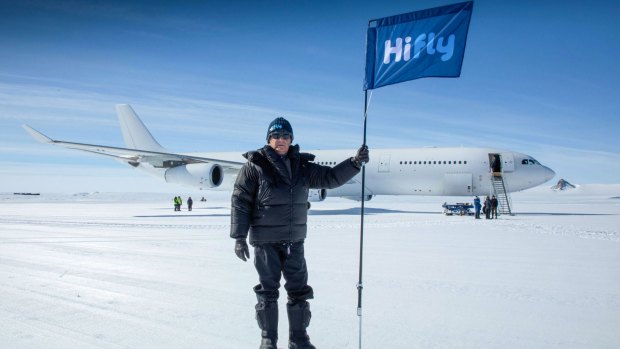This was published 2 years ago
First Airbus A340 lands on ice runway in Antarctica with Hi Fly on adventure tour

The flight was a total of 2500 nautical miles, or 4630km.Credit: MARC BOW/Hi Fly
For the first time ever an Airbus A340 has landed on an ice runway in Antarctica.
Operated by Hi Fly, the jet flew from Cape Town in South Africa to the world's southernmost continent and back earlier this month, a total of 2500 nautical miles, or 4630km. It took roughly five hours to fly each way.
Hi Fly is a "wet lease" specialist airline, which means it hires out planes, crew, maintenance and insurance. Cruise company Aurora Expeditions chartered a Hi Fly jet last year to get its stranded passengers home to Australia from Uruguay after the outbreak of COVID-19.

The depth of the ice runway is 1.4km of hard air free ice.Credit: MARC BOW/Hi Fly
In this case it was hired by the company behind Wolf's Fang, a luxury adventure camp in Antarctica. Staff for the resort were onboard, as well as some cargo. Future flights will include scientists and tourists.
While flights to Antarctica are not uncommon, this was the first by an A340. Qantas Boeing 747s and Dreamliners are regularly chartered for scenic flights over the ice continent, though these do not land.
The A340 was once the longest-range airliner in the world, but fell out of favour due to its high operating costs. With four engines it could fly routes twin-engine aircraft were not allowed to operate, but this changed in 2018 after the US Federal Aviation Administration granted extended operations (ETOPS) certificates for twin-engine Boeing 787 Dreamliners and Airbus A350s.

Future flights will include scientists and tourists.Credit: MARC BOW
The high cost of operating the A340 saw Singapore Airlines end the world's longest non-stop route, from Singapore to New York, in 2013. The route returned in 2018 with the arrival of the Airbus A350-900 ULR (ultra long range). Airbus had already ended production of the A340 in 2012.
In a captain's log, pilot Carlos Mirpuri, who is also the Hi Fly Vice-President, said the flight went very smoothly, but admitted the runway itself, built on blue glacial ice, wasn't easy to spot.
"The reflection is tremendous, and proper eyewear helps you adjust your eyes between the outside view and the instrumentation. The non-flying pilot has an important role in making the usual plus extra callouts, especially in the late stages of the approach," said Mirpuri.

Pilot Carlos Mirpuri, who is also the Hi Fly Vice-President.Credit: MARC BOW/Hi Fly
"There is also no visual glide slope guidance, and the blending of the runway with the surrounding terrain and the immense white desert around, makes height judgment challenging, to say the least."
The grooves are carved into the 3000-metre long runway using special equipment to ensure the plane can brake effectively (and not slide).
In the end it was an "uneventful landing".
"When we reached taxi speed I could hear a round of applause from the cabin. We were joyful. After all we were writing history."
The turnaround was less than the expected three hours, and the A340 headed back to South Africa.
"Take off was uneventful, as so was the returning flight. Customer was happy, we were happy. All goals for this first flight had been met," said Mirpuri.
with Stuff.co.nz
Sign up for the Traveller Deals newsletter
Get exclusive travel deals delivered straight to your inbox. Sign up now.